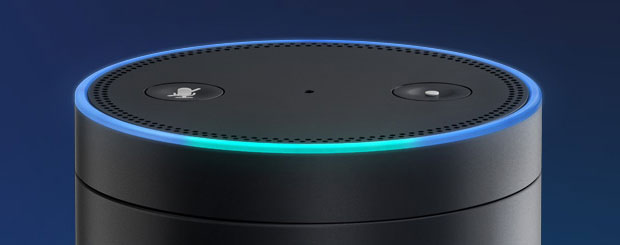Voice computing is replacing the graphical user interface, Shawn DuBravac, chief economist of the Consumer Technology Association, said early this year at CES.
Digital assistants will be integrated into many household objects, he noted.
About 5 million voice-activated digital voice products had been sold as of January, and Bravac estimated 5 million more would be sold this year.
Amazon’s Alexa voice assistant software captured 88 percent of the global intelligent home speaker market in the last quarter of 2016, according to Strategy Analytics.
That widespread acceptance suggests that it could be in Alexa’s power to disrupt multiple industries as the world increasingly goes digital and the Internet of Things becomes the norm — including retail, travel, the automobile industry, customer interactions, e-commerce, security cameras, intelligent homes, and through integration with semiconductors, pretty much everything else.
“Alexa’s very popular because of its open platform approach,” commented Trip Chowdhry, managing director of equity research at Global Equities Research.
However, its success “depends on a smart company that knows how to integrate it into their platform,” he told the E-Commerce Times. “Not every device using Alexa will be successful.”
Boots on the Ground, Metaphorically Speaking
Smart appliances using Alexa and other voice assistants are available from home appliance makers including LG, Bosch, GE and Kenmore.
Then there are the Arlo security cameras, which support Alexa.
“The old world was, you put in your wires, put in your system, and stream it 24 hours a day and you’re still clueless,” Chowdhry observed.
The Arlo platform is unique “because you have a very smart device running in an unfettered mode which can do visual intelligence in the cloud and can be controlled and enabled through voice commands,” he explained.
Several automobile companies, including Ford, BMW and Hyundai, are rolling out Alexa capabilities, or “skills,” as they’re called.
Alexa in Retail
Amazon recently relaunched the Dash Wand, with the Alexa voice assistant built in. It lets consumers scan barcodes of items on store shelves and add them to their shopping cart, or use voice commands to place shopping orders through Amazon’s Dash consumer goods ordering service.
The possibilities for such devices are “basically limitless,” noted Stephen Kaufman, chief product officer at Blue Software.
However, their use requires consumer goods manufacturers to provide accurate and rich product data on the bar code.
“If the data’s incomplete or inaccurate, the brand will risk a slide in consumer trust or confidence,” Kaufman told the E-Commerce Times.
With the advent of this technology, the entire retail landscape “could shift to a substantially different model,” he observed.
Shopify Plus merchants soon will have access to ChatBot, Linc Global’s voice and digital customer service and engagement platform, which will let them offer branded customer ChatBots on Facebook Messenger and WhatsApp, as well as voice assistance through Amazon Alexa and Google Home.
Voice-Enabling Customer Facing Tech
Voice technologies are gaining ground in customer relationship management, but users still have to make sure they “deliver the right experience contextual to the customer’s need at his or her moment of need,” emphasized Ying Chen, Pegasystems’ head of platform product marketing.
However, the technology has to evolve more to become pre-emptive, and “this is where transparent [artificial intelligence] comes in,” she told the E-Commerce Times.
Businesses implementing CRM or other customer-facing technologies with voice capability need speech analytics to “quickly adapt or modify strategies to best meet and exceed customer expectations and provide a frictionless experience,” cautioned Brian Laroche, CallMiner’s director of program marketing.
CallMiner’s products automate and analyze 100 percent of customer interactions, he told the E-Commerce Times, quickly searching and identifying context-based critical business challenges in four main areas: contact center efficiency; agent performance; risk and compliance; and the customer experience.
They let businesses respond to operational inefficiencies, poor agent behaviors, customer dissatisfaction and other issues before they can impact the bottom line, Laroche added.
Splice Software recently released a new Alexa skills app that lets CRM pros in retail, insurance and finance industries connect with customers where, when and how they prefer.
Alexa in the Travel Industry
Consumers soon may be able to use voice commands to book trips and check into hotel rooms, among other things.
“Voice-activated Internet is looking more and more like it will eventually replace the mobile app universe and, in this context, the rise of voice-activated search may upend direct booking wars between suppliers and third parties,” suggested Carl Livadas, VP of data science at Sojern, which offers traveler marketing to hotels, airlines, rental car companies and others travel industry companies.
“We’re not only seeing brands like Marriott testing both Siri and Alexa, but some brands are even developing their own signature technologies,” he told the E-Commerce Times.
AI and machine learning will be incorporated with voice to offer a full personalized experience, but this “will take a lot of back-end work from travel brands to educate customers and to provide the right responses,” Livadas said.
Chip Ahoy!
Qualcomm eXtension Program members Sensory and Rubidium support the Alexa wake word on the Qualcomm CSR8670 and CSR8675 Bluetooth Audio SoCs (systems on chips). Bluetooth products made with them can be operated with Alexa voice commands.
Semiconductor maker Microsemi is offering the Microsemi AcuEdge Development Kit for Amazon AVS (Alexa Voice Service), which can be used for emerging human-to-machine applications in the Internet of Things, Industrial Internet of Things, and automated assistance markets.
“Although getting better each day, voice recognition is still more inaccurate than accurate, limiting its use to non-critical applications such as information and entertainment,” said Nucleus Research CEO Ian Campbell.
The situation will improve, and eventually it will be possible to envision an airline pilot “making a [radio] frequency change request to a virtual assistant,” he told the E-Commerce Times, “rather than entering the frequency by pressing buttons or turning knobs.”
























































certainly, Alexa is making life easier and looks will make it even better in the coming days.